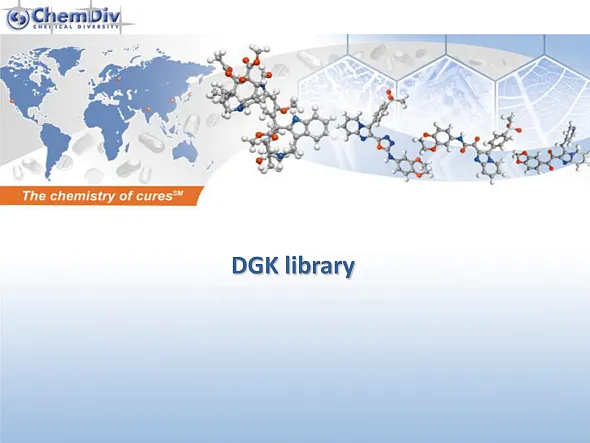DGK Inhibitors Library
ChemDiv’s library of DGK inhibitors contains 12,000 chemically diverse compounds.
Diacylglycerol kinase (DGK or DAGK) is an enzyme family that catalyzes the conversion of diacylglycerol (DAG) to phosphatidic acid (PA) by utilizing ATP. In non-stimulated cells, DGK activity remains low, allowing DAG to contribute to glycerophospholipid biosynthesis. However, upon receptor activation in the phosphoinositide pathway, DGK activity increases, driving the conversion of DAG to PA. Since both DAG and PA are considered bioactive lipid signaling molecules with distinct cellular targets, DGK plays a critical role in cellular signaling by acting as a regulatory switch, controlling the balance between diacylglycerol and phosphatidic acid, both of which are key bioactive lipids with distinct signaling functions.
DGK expression is notably high in cancer cells, particular in hepatocellular carcinoma and melanoma cells. In hepatocellular carcinoma, DGK is implicated in cancer progression and acts as a positive regulator of cell proliferation through the Ras/Raf/MEK/ERK pathway. In melanoma cells, DGK positively influences tumor necrosis factor-α-dependent activation of nuclear factor-κB (p65) via the protein kinase-mediated phosphorylation of p65 at Ser311. Consequently, inhibiting DGK activity is expected to impede the progression of these cancers [1].
In cancer cells, DGK is overexpressed or hyperactive, leading to dysregulated signaling that promotes tumor growth and resistance to apoptosis. Therefore, targeting DGK for inhibition presents a promising therapeutic approach. By impeding the action of DGK, it is possible to disrupt these aberrant signaling pathways, potentially inhibiting tumor progression, reducing cancer cell proliferation, and enhancing the effectiveness of existing cancer treatments. This approach underscores the importance of DGK as a target in the development of new oncological therapies, offering hope for more effective treatment strategies in the fight against cancer.
The library of small molecule compounds with DGK-inhibiting properties offers significant benefits for drug discovery, particularly in oncology. By providing a diverse array of DGK inhibitors, our library serves as a valuable resource for identifying and developing potential therapeutic agents that can target and disrupt aberrant signaling pathways in cancer cells. The availability of these compounds accelerates the research and development process, enabling scientists to efficiently screen and evaluate multiple candidates for their efficacy and safety in inhibiting DGK activity. Furthermore, the diversity within the library increases the likelihood of discovering compounds with optimal pharmacokinetic and pharmacodynamic properties, and potentially, molecules that can overcome drug resistance mechanisms. Thus, our library is not just a tool for advancing our understanding of DGK's role in cancer but also a springboard for the development of new, targeted cancer therapies.
References
[1] K. Liu et al., “A novel diacylglycerol kinase α-selective inhibitor, CU-3, induces cancer cell apoptosis and enhances immune response,” J. Lipid Res., vol. 57, no. 3, pp. 368–379, 2016, doi: 10.1194/jlr.M062794.
